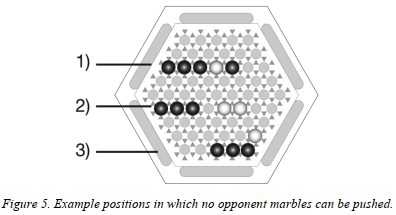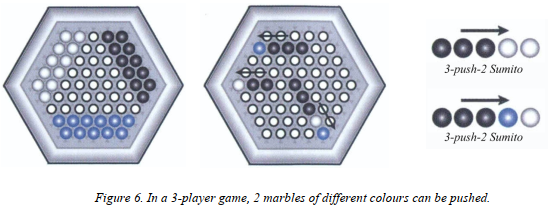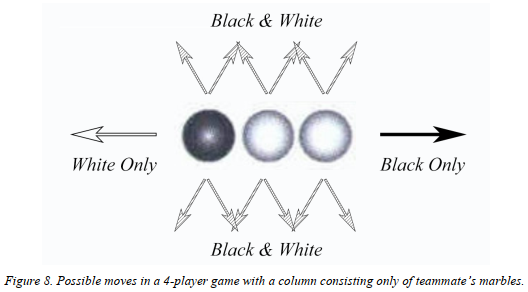Module 2 Software Systems 2019/2020 Version 2, 18-12-2019 Project game Abalone
Good luck!
Material
- Game board with 61 spaces for marbles.
- Marbles:
- 2-player: 28 marbles (14 black and 14 white).
- 3-player: 33 marbles (11 black; 11 white; 11 blue).
- 4-player: 36 marbles (9 black; 9 white; 9 blue; 9 red).
In this game description, we show examples that refer to some specific colours. In your implementation, you are free to choose a colour scheme, as long as different players can be uniquely distinguished.
Objective
To be the first player (or team) to push six of the opponent's marbles out of play, i.e., off the board.
Set up
Figure 1 shows a schematic representation of the starting positions of the Abalone board for 2, 3 and 4-player games. 
The game
A randomly selected player starts the game. In case of games with 3 and 4 players, turns move clockwise.
On their turn, each player may move either a single marble or a Column of marbles of their own colour one space. A Column consists of two or three marbles of the same colour directly adjacent to one another in a straight line. A marble or a column can move in any direction in an in-line move or side-step move, as shown in Figures 2 and 3, respectively.

All marbles in a Column must move in the same direction, as shown in Figure 3. Unless in a Sumito position, as described below, a marble or a Column must move into a free space. This means that is it not allowed to commit suicide, i.e., you may not push or move yourself off the board.
Sumito (2 players)
When a player’s Column faces a lesser number of the opponent's marbles, the player has a Sumito, or advantage. In a Sumito position, a player’s Column of three marbles may push one or two of the opponents’ marbles one space, or a player’s Column of 2 marbles may push one of the opponent's marbles one space. (Figures 4.1, 4.2, 4.3).
It is important to note the following:
• In a Sumito position, when pushing marbles, the opponent’s marbles must be pushed either into an unoccupied space or off the board. In Figure 4, that would be in the outer rim. In your implementation, the outer rim does not need to be visualised.
• Marbles pushed off the board are no longer in play.
• A single marble can never push an opposing marble, nor can a Column push any marble if it moves sideways (in a side-step move).
• Enemy marbles sandwiched between friendly marbles, as shown in Figure 5, are not allowed to be pushed.
• You are not allowed to push more than 3 marbles of your colour at the same time. Columns over 3 are not considered, so Sumitos of 4 against 3, 5 against 2, etc. are not possible.

In Figure 5, black cannot push white marbles for the following reasons:
1) The white marble is sandwiched between the black marbles. Therefore, there is no free space for the white to be pushed to.
2) The black and the white columns are separated by a free space.
3) A side-stepping column cannot push any opposing marble.
Sumito (3 players)
The rules for 3 players are identical to the rules for 2 players, with one change: with 3 marbles of their colour, a player can push 2 marbles of different colours. For example, three black marbles can push a white and blue marble.
Sumito (4 players)
When playing with four players, two teams are formed, where players facing each other form a team. In the example of Figure 7, the black-and-white team competes against the blue-andred team. The turns of teammates are never directly after each other, i.e., the order will be teammate 1 à opponent 1 à teammate 2 à opponent 2 à teammate 1 à …
In a 4-player game, a Sumito can be formed with marbles of the same team. The first marble in the pushing line must belong to the player who makes the push. You can push marbles belonging to both opponents, as shown in Figure 7.

In a 4-player game, when not in a Sumito position you may still move a column containing marble(s) of your teammate. The following rules apply:
- The column must contain at least one marble that belongs to you.
- Side-step moves are allowed by both team members.
- In-line moves are only allowed if the first marble in the pushing line belongs to the current player.
- It is not allowed to commit suicide, i.e., it is not allowed to push or move either your marbles or your teammate’s marbles off the board.

Game end
The game ends when one of the players succeeds in pushing off 6 opponent’s marbles, without distinction of colour. When playing with four players, a team of two players wins when it has pushed off 6 marbles of the opposing team.
Change log
18-12-2019- Clarified that it is not allowed to commit suicide. Specifically:
- Added the specific remark that in a 4-player game, the turns of players in the same team are never directly after each other.
- Added a specification of which column moves are allowed in a 4-player game when not in a Sumito position and when the column consists of marbles of both teammates (Figure 8).
2019-12-19